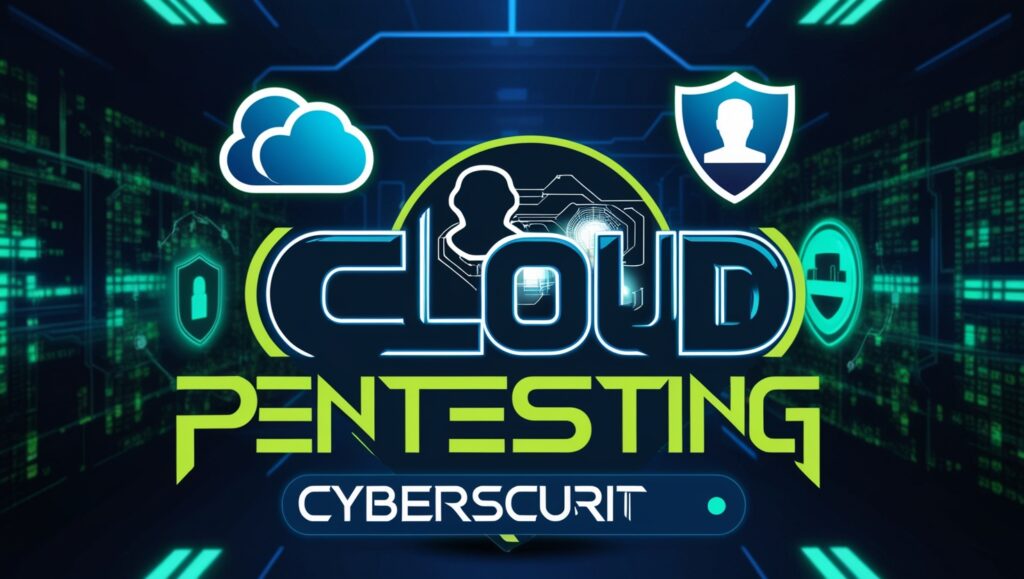1. Introduction to Cloud Pentesting
Cloud Pentesting is the process of assessing cloud environments to identify security vulnerabilities that could be exploited by attackers. As businesses increasingly migrate to the cloud, ensuring security becomes a top priority. Cloud Pentesting helps organizations uncover misconfigurations, weak access controls, and other security gaps that could put sensitive data at risk.

2. Understanding Cloud Environments
Before diving into Cloud Pentesting, it’s crucial to understand different cloud environments. The cloud is categorized into three main types:
- Public Cloud (AWS, Azure, GCP): Managed by third-party providers and accessible over the internet.
- Private Cloud: Exclusive to a single organization, providing greater control over security.
- Hybrid Cloud: A combination of public and private clouds, offering flexibility in workload management.
Each environment presents unique security challenges, making Cloud Pentesting essential for identifying weaknesses.
3. Cloud Pentesting Methodology
The process of Cloud Pentesting follows a structured methodology:
- Reconnaissance: Gathering information about cloud assets, subdomains, and publicly accessible services.
- Enumeration: Identifying misconfigurations in cloud storage, IAM roles, and API endpoints.
- Exploitation: Attempting to exploit misconfigurations or weak credentials to gain unauthorized access.
- Privilege Escalation: Moving laterally within the cloud environment to gain higher privileges.
- Persistence and Cleanup: Testing if attackers can maintain access and assessing the effectiveness of logging and monitoring.
4. Common Cloud Security Vulnerabilities
Cloud environments have unique vulnerabilities, including:
- Misconfigured Storage Buckets: Publicly accessible S3 buckets or Azure Blob storage exposing sensitive data.
- Weak IAM Policies: Over-permissive IAM roles allowing unauthorized access.
- Insecure APIs: Poorly secured cloud APIs exposing sensitive data to attackers.
- Lack of Network Segmentation: Unrestricted traffic flow between cloud assets, increasing attack surface.
- Serverless Security Risks: Insecure Lambda, Azure Functions, or Google Cloud Functions leading to code execution vulnerabilities.
Cloud Pentesting helps mitigate these risks by proactively identifying and fixing security flaws.
5. Tools for Cloud Pentesting
Several tools can be used for Cloud Pentesting, including:
- AWS CLI, Azure CLI, and GCP CLI: Essential for interacting with cloud services.
- Pacu: AWS exploitation framework for pentesters.
- ScoutSuite: Multi-cloud security auditing tool.
- CloudSploit: Automated cloud configuration scanner.
- Prowler: AWS security best practices assessment tool.
These tools aid pentesters in uncovering vulnerabilities and misconfigurations within cloud environments.
6. Legal and Compliance Considerations
Cloud Pentesting must adhere to legal and compliance regulations. Organizations must:
- Obtain Cloud Provider Approval: AWS, Azure, and GCP have strict pentesting policies requiring prior approval.
- Follow Compliance Standards: Ensure testing aligns with GDPR, HIPAA, and PCI-DSS requirements.
- Respect Shared Responsibility Model: Cloud security is a shared responsibility between providers and users.
Failure to comply with legal guidelines can result in legal actions or service disruptions.
7. Case Studies: Real-World Cloud Pentesting Scenarios
Examining real-world cases highlights the importance of Cloud Pentesting:
- Unsecured S3 Buckets: Numerous companies have suffered data breaches due to publicly accessible storage buckets.
- Misconfigured IAM Roles: Attackers gaining unauthorized access due to excessive permissions.
- Exposed API Keys: Developers unintentionally leaking API keys on GitHub, leading to cloud account compromises.
These cases emphasize the necessity of continuous security assessments through Cloud Pentesting.
8. Best Practices for Cloud Security
To enhance cloud security, organizations should:
- Enable Multi-Factor Authentication (MFA): Strengthens user authentication.
- Regularly Audit IAM Policies: Restrict permissions based on the principle of least privilege.
- Encrypt Sensitive Data: Ensure data is encrypted in transit and at rest.
- Monitor Cloud Logs: Use AWS CloudTrail, Azure Monitor, and GCP Logging for real-time security monitoring.
- Perform Regular Cloud Pentesting: Continuous security assessments help identify and fix vulnerabilities.
9. Conclusion
Cloud Pentesting is a crucial process for securing cloud environments from evolving threats. With organizations increasingly relying on cloud infrastructure, regular security assessments help mitigate risks associated with misconfigurations, weak access controls, and API vulnerabilities. Implementing best practices and using effective pentesting tools ensures a secure cloud environment.
10. FAQ Questions
Q1: Is Cloud Pentesting legal?
A1: Yes, but it requires approval from cloud providers like AWS, Azure, and GCP to comply with their security policies.
Q2: How often should Cloud Pentesting be performed?
A2: Regularly, at least quarterly, or after any significant cloud infrastructure changes.
Q3: Can Cloud Pentesting prevent all cyber threats?
A3: While it helps identify vulnerabilities, a combination of pentesting, continuous monitoring, and security best practices is needed for complete protection.
Q4: What are the most common cloud vulnerabilities?
A4: Misconfigured storage, weak IAM policies, insecure APIs, and lack of proper network segmentation.
Q5: What tools are best for Cloud Pentesting?
A5: Pacu, ScoutSuite, Prowler, AWS CLI, Azure CLI, and GCP CLI are some of the most effective tools.
Cloud Pentesting is an essential security practice that organizations should prioritize to protect their cloud assets from cyber threats. Ensuring robust security practices and regular pentesting helps safeguard sensitive data and cloud infrastructure from malicious actors.
Check More Blog:- https://thetechcrime.com/role-of-ai-in-cybersecurity/
Check My YouTube Chenal:- https://www.youtube.com/@Thetechhacker231

Leave a Reply